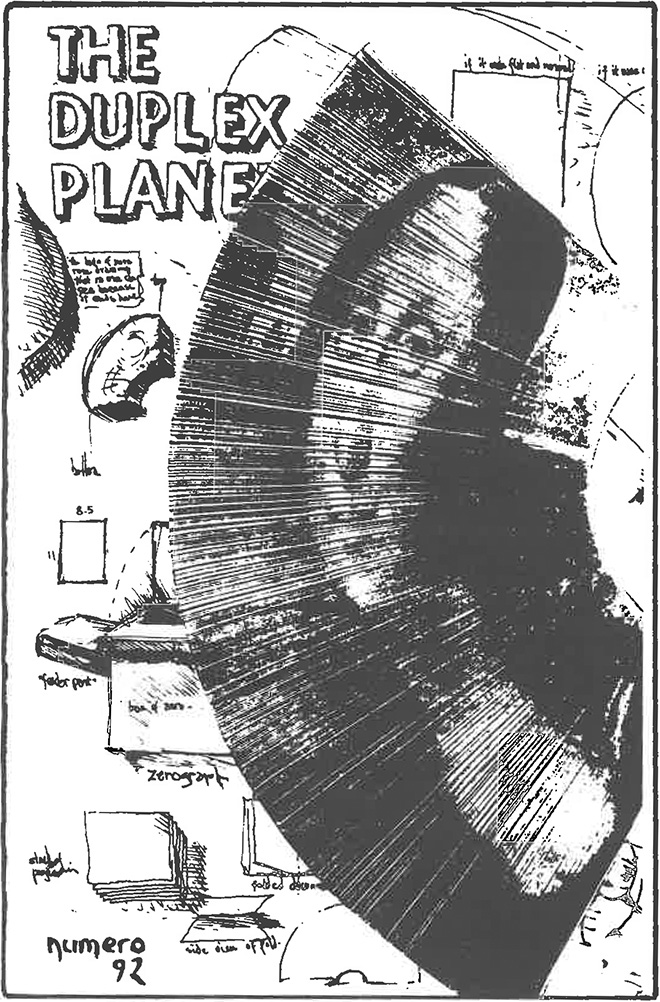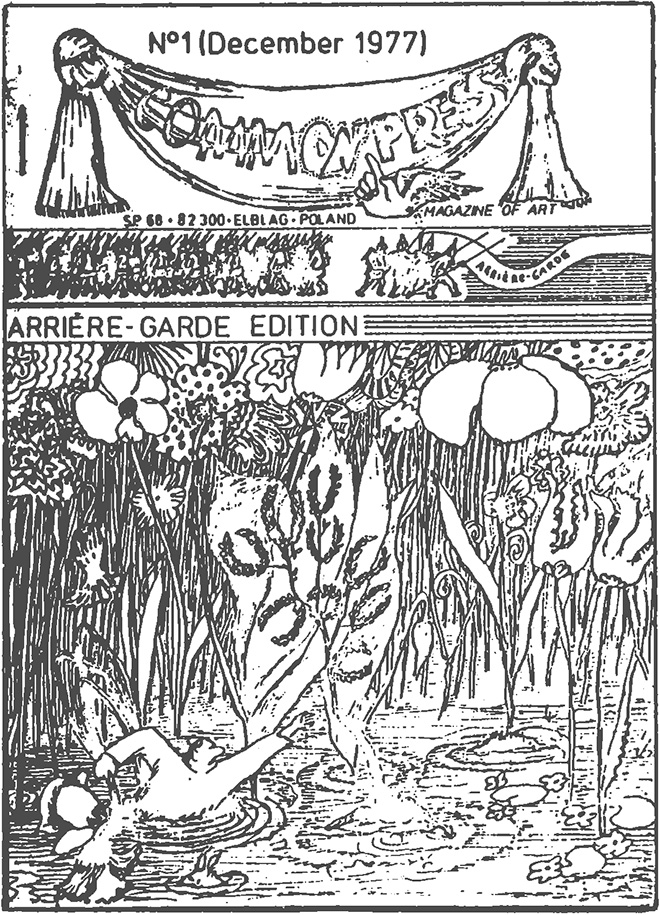Perneczky Géza: Discovering Magazines (excerpt)
in: Perneczky, Géza: The Magazine Network. The Trends of Alternative Art in the Light of their Periodicals 1968-1988, Soft Geometry, Köln, 1993, pp. 14–16.

David Greenberger: The Duplex Planet. No 92. 1988
If we look at the issue titles of the most significant mail art series, Commonpress, we get a step closer to reality again. Indeed, they’re so shockingly similar to the subjects of the Duplex Planet: “What is the difference between open and closed? Eroticism and art. From poetry to poesy. Box boxing boxers. Ideas and wheels. Slight of hand. Positiv-negativ. Spéciale Italia. Post office. Diary pages. White lies. Can the artist help survive? Shoes - go anywhere you please. Handstamped selfportraits. Artists’ postage stamps. Modem greek - modem turk. Nudes on stamps. Pigeons of freedom. Children. Alphabets. You can know more than we can tell. Political satire: post scriptum. Ethics and art. Ruins. Zen and art. Problems in information arts. Drawing activity. Ladies: black and white. Light. Meetings..”. And so on, and so forth. The first issue of Commonpress series still lacked a subtitle. The subjects listed here come from the second to the thirty-first issues.
The “oblique light” is there in these titles as well, notwithstanding that they also include such academic subjects as morals and art, or poetry and poesy... These publications were in fact anthologies in which each page was contributed by a different artist. The colourful hodge-podge as a rule brings down to earth even the most high-flying and aesthetic thoughts. Thumbing through a few Commonpress issues, we can see for ourselves that the menu is the same, only the inscription on the plate is changed. Normally, an artist has the same in mind irrespective of whether he’s talking about the pigeons of peace or ideas and wheels - strange as it may sound, this is their strong point. After all, whatever’s true without being conventional is per se realistic. And this reality, if we take a closer look at it, is the same everywhere.
This makes the idiots’ statements congenial, and this is why the alternatives’ utterances are very much the same (they’re true, although they may sometimes be banal as well).
Now is the time to recount the birth of the Commonpress. This publication was established by the Polish mail artist Pavel Petasz. His aim was to lay down the editorial rules for a “common” magazine that can act as a relay baton. The paper had a central coordinator, who assigned each issue to an “editor”. Then the editors chose a subject, and announced the proposed format and editorial deadline. Since Commonpress was agreed to be issued in 200 copies only, the contributing artists were advised to submit their works in the same number of copies. Each issue was obliged to announce the addresses of the designated editors of the next issue, and also a number of other particulars. Consequently, Commonpress was not a one-off publication: instead, it had eight to ten issues in the hands of different editors simultaneously. The issues were then released at random, quite often by the dozen a year.
The mail artists and the alternatives have always had a latent desire for such permutations, and Petasz’s Commonpress idea legalized and institutionalized this practice. All Petasz had to do was to develop further the “assembling”, which had been common since the late sixties, and which will be discussed in detail in Chapter 3. At this point, I wish to call attention only to the striking similarity between the editorial principles of Commonpress and Gunther Ruch’s parallelogramme-shaped diagram. Of course, Commonpress was more like a complicated polygon, whose potential diagonals pointed to the most diverse directions. In fact, this loose society also had lots in common with the use of pseudonyms and the alternating magazine titles. As though the artist (block capitals throughout) stepped back to amalgamate with the scenery, in order to direct the public’s attention from his own self to the scene.
Pawel Petasz was coordinator of Commonpress until 1981 only. In that year, due to the difficulties presented by the Polish postal service, that role was taken over by the Canadian Jupitter- Larsen. By then, some fifty issues had appeared of this itinerant periodical. The new coordinator was right to exclaim that Commonpress was no more an alternative magazine, but an expanding international performance.

Pawel Petasz: Commonpress No 1. 1977
Not long after the 50th issue came out, I had a chance to see all the previous Commonpress publications. The occasion was an exhibition which Guy Bleus organized in the museum of a small Belgian town6 of the 621 (!) works that were submitted to the “aerogrammes”, i.e. the 56th issue which he himself edited. The event had something markedly unlikely about it: upon entering the show.
I had the impression that I was walking in the scene of a Magritte painting instead. Besides hanging on the walls hundreds of drawings on identical air mail cards in what seemed to be an endless and absurdly pedantic row, Guy also exhibited in the middle of the showroom his own workdesk, as a symbol of “clerkdom” choked by red tape (no wonder he called his workshop “Administration Centre”).
In fact, the desk itself was so very unrealistic as it stood there clean and tidy. But that was no match for the polished glass-cases with chromium-plated frames next to it, which contained the pride of Guy’s collection, the complete Commonpress series. I was one of the few foreign guests there, so Guy spared no time to drag me away from the sterile cases stuffed with all those colourful prints just to introduce me to the city mayor and his company. It was this tuxedos and bowlers kind of stuff.
Consequently, Commonpress has remained in my memory as an inaccessible piece of art history, which was polished and raised to the glossy heavens by a gentleman in tuxedo and bowler hat. Later in time, I paid a few visits to Guy’s home, but we’ve never had the time to thumb through these Commonpress issues. In fact, I have also collected a few copies in the meantime, and so this treasure ceased to be “inaccessible” to me.
* * *
Another peculiarity of the Commonpress-type compilations is that after a while the regularly contributing artists become members of a kind of community, and in that spirit they can cooperate almost flawlessly. However, these friendly ties are bound to remain on an abstract level, since they function exclusively in the field of artistic communication.
